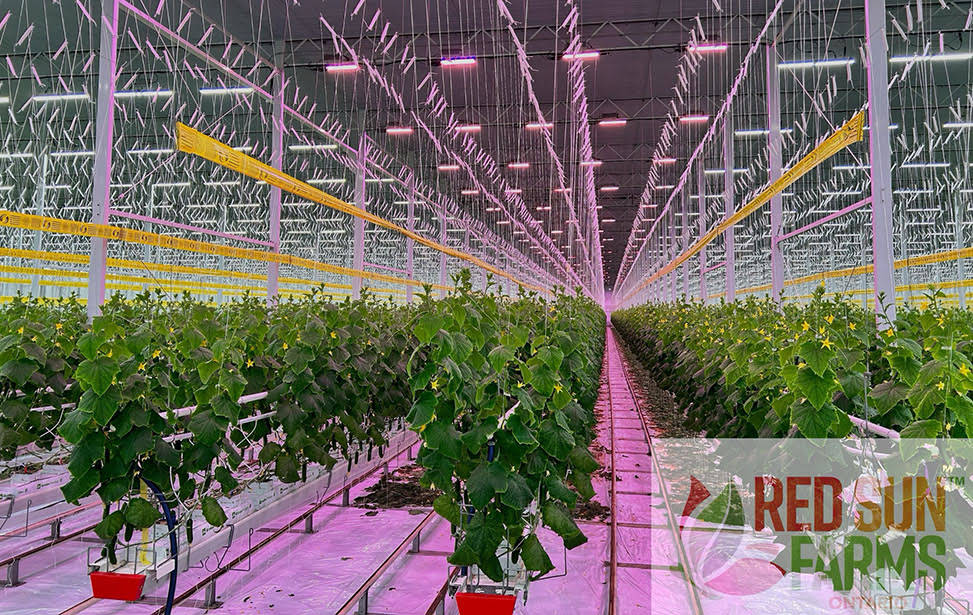- English

Recent advancements in greenhouse technology have sparked considerable interest among growers, especially regarding the use of far-red light in crop cultivation. Far-red light, which is part of the light spectrum just beyond visible red light, has been shown to influence plant behaviors such as flowering and growth patterns. Seizing this opportunity, Red Sun Farms Ontario is undertaking an innovative project to evaluate the potential benefits of
far-red and dynamic lighting. The company is conducting comprehensive tests comparing Sollum’s smart LED grow light fixtures and SUN as a Service® platform, known to work together to adjust light spectra to plant growth stages, against traditional fixed spectrum lighting. This initiative aims to scientifically measure improvements in crop yield, quality and growth efficiency, thereby setting new standards in precision agriculture.
Located in Kingsville, Ontario, Red Sun Farms Ontario is a state-of-the-art, 1.2 million square foot greenhouse. Embarking on their 4th growing season, cultivation includes 21.5 acres of several different tomato varieties grown conventionally and 6 acres of mini cucumbers grown under LED lights. In a bold move to further elevate their quality standards, Red Sun Farms Ontario is initiating cutting-edge mini cucumber growth trials. This research will compare the effectiveness of LED fixed spectrum lighting against the innovative capabilities of Sollum’s dynamic lighting technology.
Recent studies have demonstrated the significant role of far-red light in certain growth stages, particularly in enhancing desirable traits like stem elongation. This aspect is crucial for vining crops such as cucumbers, where longer stem internodes can markedly improve airflow and overall plant health. By exploring these advanced lighting
techniques, Red Sun Farms Ontario aims not only to optimize cucumber growth but also to spearhead a new era in precision-driven greenhouse cultivation.
“We are excited to partner with Sollum on this trial as we are on the cusp of expanding our facility and looking for the best LED lighting solution available to grow efficiently and sustainably. Our research and development projects are an essential part of our success as a greenhouse producer,” says General Manager Sarah Lombardi of Red Suns Farms Ontario. “Current science is saying that changing the red to far-red ratio in supplemental lighting has a significant impact on plant morphology and we want to see those impacts for ourselves in our own greenhouse,” she continues. “While other lighting solutions allow us to look at the effects of including far-red in fixed spectrum LEDs, Sollum’s solution gives us the additional capabilities of observing how dynamically changing that ratio over time might provide added benefits to our crops. Not to mention, having the flexibility of adjusting the fixture’s intensity when needed means electrical cost savings for the farm when installed on a larger scale.”
Frank Peters, Master Grower at Red Sun Farms Ontario, adds “This is an exciting next chapter for me, furthering my knowledge in supplemental lighting. I’ve experienced growing crops under HPS and standard LED lights, but dynamic lighting is a new venture. The prospect of developing data-driven lighting recipes tailored to different stages of plant growth is fascinating.”
“Many studies have been and are currently being conducted on the benefits of manipulating the red to far-red ratio for crop yield, harvest time, fruit production and many other growth indicators,” says Agronomist Rose Séguin for Sollum Technologies. “These research studies are often finding that the positive impacts of adding far-red are timing dependant ― i.e., it should be added at a higher ratio during specific times of the day or specific growth stages in order to produce the desired result,” she continues. “Only a dynamic LED lighting solution like Sollum’s allows growers like Red Suns Farms to manipulate the red to far-red light ratio over time in order to maximize benefits.”
For more information about Sollum’s LED grow light solution and the science behind far-red light, visit the company’s website and read the white paper Photoreceptors and Red/Far-red Impacts.